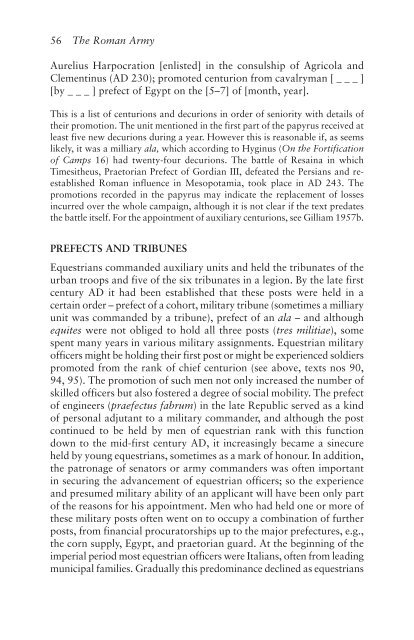The Roman Army, 31 BC–AD 337: A Sourcebook
The Roman Army, 31 BC–AD 337: A Sourcebook
The Roman Army, 31 BC–AD 337: A Sourcebook
Create successful ePaper yourself
Turn your PDF publications into a flip-book with our unique Google optimized e-Paper software.
56 <strong>The</strong> <strong>Roman</strong> <strong>Army</strong><br />
Aurelius Harpocration [enlisted] in the consulship of Agricola and<br />
Clementinus (AD 230); promoted centurion from cavalryman [ _ _ _ ]<br />
[by _ _ _ ] prefect of Egypt on the [5–7] of [month, year].<br />
This is a list of centurions and decurions in order of seniority with details of<br />
their promotion. <strong>The</strong> unit mentioned in the first part of the papyrus received at<br />
least five new decurions during a year. However this is reasonable if, as seems<br />
likely, it was a milliary ala, which according to Hyginus (On the Fortification<br />
of Camps 16) had twenty-four decurions. <strong>The</strong> battle of Resaina in which<br />
Timesitheus, Praetorian Prefect of Gordian III, defeated the Persians and reestablished<br />
<strong>Roman</strong> influence in Mesopotamia, took place in AD 243. <strong>The</strong><br />
promotions recorded in the papyrus may indicate the replacement of losses<br />
incurred over the whole campaign, although it is not clear if the text predates<br />
the battle itself. For the appointment of auxiliary centurions, see Gilliam 1957b.<br />
PREFECTS AND TRIBUNES<br />
Equestrians commanded auxiliary units and held the tribunates of the<br />
urban troops and five of the six tribunates in a legion. By the late first<br />
century AD it had been established that these posts were held in a<br />
certain order – prefect of a cohort, military tribune (sometimes a milliary<br />
unit was commanded by a tribune), prefect of an ala – and although<br />
equites were not obliged to hold all three posts (tres militiae), some<br />
spent many years in various military assignments. Equestrian military<br />
officers might be holding their first post or might be experienced soldiers<br />
promoted from the rank of chief centurion (see above, texts nos 90,<br />
94, 95). <strong>The</strong> promotion of such men not only increased the number of<br />
skilled officers but also fostered a degree of social mobility. <strong>The</strong> prefect<br />
of engineers (praefectus fabrum) in the late Republic served as a kind<br />
of personal adjutant to a military commander, and although the post<br />
continued to be held by men of equestrian rank with this function<br />
down to the mid-first century AD, it increasingly became a sinecure<br />
held by young equestrians, sometimes as a mark of honour. In addition,<br />
the patronage of senators or army commanders was often important<br />
in securing the advancement of equestrian officers; so the experience<br />
and presumed military ability of an applicant will have been only part<br />
of the reasons for his appointment. Men who had held one or more of<br />
these military posts often went on to occupy a combination of further<br />
posts, from financial procuratorships up to the major prefectures, e.g.,<br />
the corn supply, Egypt, and praetorian guard. At the beginning of the<br />
imperial period most equestrian officers were Italians, often from leading<br />
municipal families. Gradually this predominance declined as equestrians



